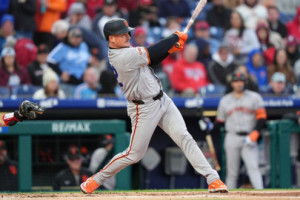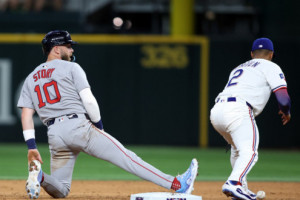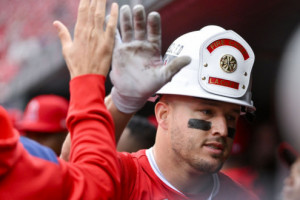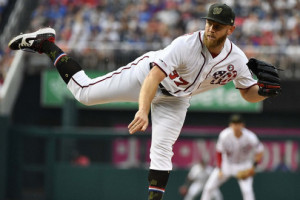Pre-Musings - CheeseIsGood's 2020 Daily Fantasy Baseball Prep: Part 4
For this episode of the Pre-Musings, I’m going to touch on a few different topics that cause a lot of arguments and misunderstanding in daily fantasy baseball year after year. Much like politics, I do not expect all of you to agree with me on all these topics, but it is important that you know where I’m coming from and why.
This whole article is mostly of me sounding like a cranky old ‘get off my lawn’ kind of guy, and as it turns out, that’s exactly the kind of guy I am! This is also a great opportunity to get some Mitch Hedberg into action early this year:
“I think Bigfoot is blurry, that’s the problem. It’s not the photographer’s fault. Bigfoot is blurry, and that’s extra scary to me. There’s a large out-of-focus monster roaming the countryside. Run, he’s fuzzy, get out of here.”
- Build DFS Lineups Like a Pro!
- Access to Content and LineupHQ
- MMA, KBO, Soccer and PGA
BvP – It’s About To Get Ugly In Here

Nothing causes more drama in baseball analysis than our old friend BvP. If you’re new to this stuff, BvP stands for Batter vs Pitcher, referring to the history of results when a particular batter faces a particular pitcher. I wrote an extensive article about this a couple years ago that you can read here if interested. But, here’s the gist – Of course, BvP is “real” in some circumstances, but we have absolutely no way of knowing which cases are “real” and which are sample size noise. Let me pause here and say that if you are going to be one of the people who responds to this by saying, “if you’ve ever played sports, you’ll know that BvP is real,” that means you are not hearing what I’m saying. The question is not whether or not certain players have a psychological edge over other players that can show up in BvP. The question is if we can have any idea which of these cases are believable based on the data we have. And we can’t- we just can’t. That doesn’t mean you aren’t allowed to look at it and use if you see fit. Some people have just made up their minds that they are going to use BvP, and hey, that’s fine.
It is just important that if you’re reading my content, you know where I’m coming from and what I do and do not use in my own analysis. I do not look at BvP, I do not consider BvP, and most days in most cases, I am not even remotely aware of BvP. There are a few reasons for this:
First and most obvious is the plain old sample size. There are very few batters who have faced a specific pitcher more than a handful of times. Even if you get up to 30-40 AB against a certain pitcher, there is not one single statistic that stabilizes in that few at bats. Going back to the past few Pre-Musings, we talked about strikeouts being the most consistent and projectable stat. Even K% takes 60 PA to begin to stabilize, and we’re talking about far more than K%. It takes hundreds of at bats to get anything close to a useable sample size for batted balls.
There is also within that the issue of changing skill sets. One of my favorite moments from last season was being berated in Crunchtime chat for recommending Matt Chapman against Felix Hernandez because Chapman was 0-10 off Hernandez. Of course, Chapman hit a home run off Hernandez in that game, not because of BvP or lack thereof, but simply because Felix Hernandez used to be good, and now he’s not. Chapman going 0-6 off Hernandez in 2017 couldn’t possibly be less relevant in 2019. Chapman was a rookie, Hernandez was a Hall of Famer. Even in 2017 when those at bats took place, Hernandez didn’t have some magical ability to outwit Chapman as if it was in both of their heads. It was just an experienced pitcher in a six at bats getting a rookie batter out. Whoop-dee-doo.
In a similar vein to that, it doesn’t even have to be overarching career-changing skill sets, as there are also subtle changes as simple as a pitcher making adjustments to their pitch mix which happens every day, all year every year. But the bigger issue, more than anything about changing skill sets is again the old problem of variance on balls in play. The difference between a batter being 1-10 and 3-10 is oftentimes a fielder standing two feet to his left on one play, and two feet to his right on another. And we would say the 1-10 matchup is an advantage to the pitcher and the 3-10 is an advantage to the batter? Stop it.
In the most perfect world, BvP would always make sense in relation to the other matchup data. A left-handed batter with low strikeouts and lots of hard hits and line drives facing a right-handed pitcher with low strikeouts and no ground ball ability has a good matchup. That is what I am looking at. If that batter has done well against that pitcher in the past, I would say it is because of those numbers that favor the batter. If the batter has not done well against that pitcher in the past, I will say that the numbers suggest there will be positive regression moving forward.
That is my view on this- it does not have to be your view. Again, let me reiterate, I am not at all suggesting that BvP doesn’t exist. Of course it does. I am suggesting that we don’t know when and where it exists.
HOT AND COLD STREAKS – Let’s Argue Some More, It’ll Be Fun
Hot and cold streaks are the Yeti to the Bigfoot of BvP. (The Yeti is on quite a cold streak!).
Much like with BvP, of course hot and cold streaks exist. That is not the question. We can always look backwards and say a player has been hot or cold, though we may have differing definitions of what makes a streak. But the question is whether or not that helps us moving forward. When is a hot streak over? When it ends. This is my biggest issue with saying, we are supposed to play Player X because he’s hot. When does that no longer count? Is it one game going hitless? If a guy hits a home run seven games in a row and then goes 0-4 two games in a row, is he hot? Is he cold? Nobody seems to know. That is the main reason why I cringe when someone says to play this guy “while he’s hot.” They will not tell you when he’s not hot anymore, because there is no such definition.
Try this one on for size – Player X hits a home run seven games in a row. (yes, he’s been hot). Then he goes 0-4 four days in a row, a nice 0-16 stretch. In that 0-16, he hit five balls to the warning track and had three line drives caught. Is he hot? We do not know, because “hot” is not a baseball statistic.
Now, cold streaks can be of a little more use in analysis, because they can sometimes point us to an underlying injury. Personally, I think it’s a little bit more reasonable to consider ‘cold streaks’ if they meet the following criteria – they come with a significant increase in strikeouts, and/or they come with a significant drop in hard hit rate. Baseball players do get hurt all the time, and some players attempt to play through it. This is still incredibly far down my list of things to consider in this game, but if a batter is in a prolonged slump, I am willing to downgrade them slightly if they are simply not hitting the ball as hard as they usually do, as that could be a sign of injury. But we need sample size here- I’m talking a couple of weeks of data- there is no such thing as a three-day cold streak.
Where I usually end up causing rifts is with players who simply have bad results over a few days, weeks, or sometimes even months, if there is no change in their underlying skills. If a player is making contact and has similar batted ball data to their career norms, in my opinion, they are not hot or cold, and I will not treat them any differently.
Just like with BvP, you are under no legal obligation to agree with me on any of this. If you want to build rosters full of hot players with good BvP, you are completely allowed to do that and you do not need my blessing. I just want to make sure we’re all on the same page so that you’ll know what factors I am looking at in these daily articles. I am always looking first and foremost at the long-term underlying skill sets of the players. The things we looked at in Parts 2 and 3 of the Pre-Musings. Strikeouts, walks, ground balls/line drives/fly balls, hard hits. What happens once the ball is in the field of play is subject to all kinds of variance that we just can’t narrow down as accurately as we’d like. More often than not, a player is on the good or bad side of that batted ball variance more often than he’s hot or cold.
GAME STACK = Not A Baseball Term

Before we get off on the wrong foot here (a Big foot?), let me say this very clearly – you can absolutely stack two teams who happen to be playing in the same game. OK, now that is out of the way. A ‘game stack’ means something very real and very relevant in NBA DFS. When one team plays at a fast pace, the other team benefits by extension, getting more opportunities to score more points themselves. It is common sense that game stacks would be a thing in a sport in which your opponent’s pace of play and scoring directly affects yours. If Team A plays at the highest tempo in the league, then Team B will get more opportunities in that game than they usually do.
In baseball, that is not a thing. You get 27 outs. If the opposing team scores 30 runs, you still just get the same 27 outs. This is why I do not condone the use of the term ‘game stack’ in MLB. Now, there is the case where part of the reason you like a game is the weather and/or ballpark favor offense, and therefore you may end up stacking both teams in that game. But the point there is that you like each team individually, regardless of the opposing team’s offense. The second team gets no additional benefit from the fact that the first team scores a lot of runs that day. While you may call it semantics, I firmly believe that is a mistake to ever use the term ‘game stack’ in MLB. Because it means something specific in other sports, it can lead people way down the wrong path hearing that term used in MLB.
Again, please don’t take this to mean that you can’t like both offenses playing in the same game; this simply means that one team’s offense does not affect the other team’s offense like it does in other sports.
MLB PROJECTIONS

Coming straight from NBA season, where projections are the main piece of the puzzle, we need to reset our thinking on projections in MLB. The range of outcomes on hitter projections is so extreme that I personally believe they qualify as meaningless in tournaments. That’s not at all to say that projections are useless or even “inaccurate;” it’s just that the variance makes them misunderstood.
For starters, if you’re using LineupHQ or your own optimizer to build multiple lineups, of course you need some input for it to run off of. You need projections in there at some level. But saying you need projections to run a lineup builder is different than assuming those projections are going to be anything close to accurate on that particular slate. Let’s take a look at a real life example to show what I mean here.
These are the DK point totals from the last 20 games for Giannis Antetokounmpo – 58, 55, 40, 77, 58, 61, 42, 67, 67, 54, 57, 72, 68, 70, 71, 61, 65, 50, 57, 57.
That’s an average of 60 points per game with a low of 40 and a high of 77. Even more telling than that, only 3 of the 20 games did he land farther than 20% away from his average. When Giannis is projected for 60 points, you have an 80% chance that he lands between 48-72 points. Some players may be slightly more or less variant than that, but the point here is that we have a reasonable window of projectability in NBA.
These are the DK point totals from the last 20 full games of Mike Trout in 2019 – 4, 8, 9, 31, 14, 9, 8, 29, 0, 9, 0, 5, 5, 14, 9, 11, 7, 16, 0, 25
First of all, imagine Giannis scoring 0 three times a month. Trout had an average of 10.65 points per game here. But while Giannis was within 20% of his average in 17 out of 20, Trout was within 20% of his average just 7 of 20 games. It’s just different. A projected outcome for Giannis of 60 DK points is not “less correct” than a 10.5 DK point projection for Trout. It’s just that in any one game, the NBA player is much more likely to fall within a fairly tight range of that projection, while the MLB player is just as likely to score a 0 one day and a 20 the next. That’s still a 10 point average over the long run, but in one day, it really doesn’t help us.
And this is just with looking at a couple star players; the projection gap becomes even more extreme when you see how often the lowest priced, lowest projected MLB player on a slate outscores the highest priced, highest projected player. We could play NBA DFS every day for a decade, and Rodney McGruder would never outscore Giannis. But in MLB, Orlando Arcia will outscore Trout a couple times a week. They are just completely different sports.
The reason I bring all this up is not to say that we don’t need projections. They still do give us a ranking of players, show us under or overpriced options and are necessary for MME. But in my opinion, if you are a tournament player and not mass multi-entering using a lineup builder, I would tell you not to rely on hitter projections in your process. You need those high end outlier games, you do not need to know who is projected at 10.6 points and who is projected at 9.7. That difference does not mean anything in one game. You need the guys who beat their projection by 200% on that day. How do you find that? HHHHH (BTYBC). That’s from Pre-Musings Part 3 if you missed it.
LEVERAGE – Seriously, GET OFF MY LAWN

Sometime in the past couple years, we hit a tipping point in DFS, where the industry just decided that ‘leverage’ was going to be the new keyword for all things tournaments. I get it, I really do, it means something, and it’s wonderful. We should all get leverage. You need some leverage, I need some leverage, we all need some leverage. Go get the leverage, and enjoy the leverage while you leverage your way to victory.
But, here’s the thing. That term does not always mean what you think it means. Let me start by saying that ‘ownership projection,’ ‘game theory,’ and ‘leverage’ are not all the same thing and not interchangeable. Not every player who is low owned is a great play due to leverage. Playing any random batter who is low owned is not game theory. GET OFF MY LAWN.
OK, sorry, back to leverage. Let’s start by playing nice. Where I do like the use of the term leverage is the way we use it in Slate IQ, where we will look at past similar slates and see what types of stacks have had success relative to their ownership. If you can map out the likelihood at which a team will be the highest scoring stack of the day and then see how far down the projected ownership list they are, there actually is the potential to get leverage from that. I’m on board, I like it, leverage!
But, this is the one that kills me…“I am going to stack against the highest owned pitcher for leverage!!” Now, to be fair, on a very small slate, like 2-3 games, there actually is some merit to this thought, but only due to the lack of options. And, if you are MME’ing a full slate, there is merit to stacking every single team on that slate, so you might end up here. But, if you are building a few lineups or a tight core of stacks, this whole idea is bonkers on a full slate (again, just in my opinion).
Most MLB main slates have at least 8+ games, and quite often 14-15 games. Let’s take a 12-game slate as an example. There are 24 teams playing on that slate. If you are going to win a tournament with a stack, you need to find a team that is in the top three in scoring that day (again, just as a typical example; sure there are exceptions). The other 21 teams are useless as full stacks on that day. The highest owned pitcher on that slate is going to be somebody good. If that pitcher is 50% owned, you do not need him to get shellacked for a negative outing in order to be beating the field with a different pitcher. All you need is any other pitcher that outscores him by one point if you have the highest-scoring offense. If that 50% owned pitcher goes five innings and allows four runs with three strikeouts, you’ve won the fade. But stacking against him was also useless and meaningless. In fact, you’ve given up your edge in fading that pitcher by stacking against him. The reason he was 50% owned is because he’s good and doesn’t get shelled.
Meanwhile, there are plenty of other teams under 5% stack ownership that were facing far worse pitchers on that slate. Blindly stacking against the high owned pitcher is not leverage. Leverage is playing the 3% owned stack that was facing the bad pitcher; it is irrelevant whether or not anyone was using that pitcher in their lineups.
While we’re on the topic of fading highly owned players, let’s touch on this. Especially in the area of pitchers, I think we are sometimes worrying too much about looking for a pitcher to bomb in considering a fade. Here’s how I look at it:
- Pitcher A is $10,000, 50% owned and scores 20 DK points. This pitcher did not fail, did not bust, did not get shellacked. While $10k pitchers are going to have the occasional dud, we don’t need that to happen to ‘win’ a fade.
- Pitcher B is $9,900, 49% owned and scores 21 DK points. Pitcher B beats Pitcher A.
- Pitcher C is $9,800, 48% owned and scores 22 DK points. Pitcher C beats Pitcher B.
I think you see where I’m going with this. You don’t need the high owned pitcher to bust in order to beat him and make a fade worthwhile. For every dollar you save and every point you score, you’re gaining an edge on the high owned pitcher. This is just another random ‘in my opinion,’ but I think we spend too much time trying to figure out which ace is going to get shelled, both for ‘sneaky stacking’ against him, and fading him in our lineups. You really don’t need to chase the extreme small likelihood outliers- all you need to do is match his points at a lower cost or have the ace put up an average game while you have the one who hits his ceiling.
The basic point I’m making with all of this is that there are so many games and players on the average MLB slate that you don’t need to go hilariously off the board to be different.
- Build DFS Lineups Like a Pro!
- Access to Content and LineupHQ
- MMA, KBO, Soccer and PGA
CLIFF NOTES
The main point of all these ‘get off my lawn’ categories is this – I do not expect everyone to agree with me, or view things the same as I do, and that is completely OK. But it is important that you understand where I’m coming from, and what stats I do and do not consider in my analysis. This should help us avoid some confusion during the season.
Even within these categories we touched on, I am not expecting all of you to agree with me or change the way you do things. There is more than one way to play DFS and you need to find what works for you. But I do believe it’s useful to at least consider other points of view and see how you may be able to apply some of it to improve your game.
Here’s the cheat sheet with my view on these topics:
1) BvP – It is “real,” it exists, but we cannot determine when it is real and when it’s not. I do not use BvP.
2) Hot Streaks – They are real when looking backwards, but not statistically relevant looking forward. I completely understand if you use hot streaks in your analysis, and I wouldn’t tell you that you have to stop. But I am still just looking at the underlying skill sets and do not change my opinion of players or matchups based on a short-term hot streak.
3) Cold Streaks – In most cases, I completely ignore cold streaks just like with hot streaks. I am concerned with the underlying skill sets of the players and their matchups. However, I will start to consider cold streaks if they are accompanied by a drop in hard hits and a spike in strikeouts, as it can sometimes be an indicator of hidden injury.
4) Game Stacks – This is just simply not a baseball term, and I do not condone its use. You can stack two teams in the same game, but that’s just what it is- two separate teams that you like individually who happen to be playing in the same game. Semantics, schemantics.
5) Projections – Projections are not “incorrect,” but the day-to-day variance in MLB makes batter projections essentially meaningless in tournaments due to the extreme range of outcomes. You’ll need to use them if MME’ing, but I do not consider them when hand-building lineups.
6) Leverage – Of course you are going to consider ownership in your tournament builds, but that doesn’t mean you have to get silly. Stacking against the best pitcher on a full slate is not leverage, it’s –EV.
Really, I’m a pretty friendly guy, but GET OFF MY LAWN!
Pre-Musings Part 1
Pre-Musings Part 2
Pre-Musings Part 3
Pre-Musings Part 4

